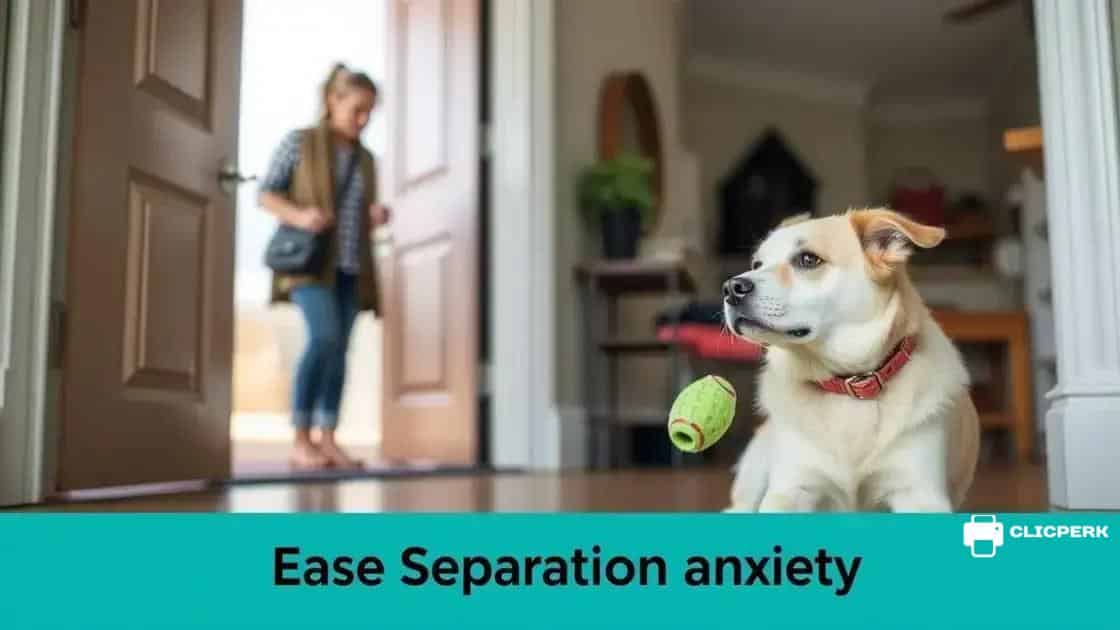Dealing with separation anxiety: tips for a smoother experience

Anúncios
Dealing with separation anxiety in pets involves creating a calming environment, establishing routines, using engaging toys, and seeking professional help for severe cases to ensure their comfort and well-being.
Dealing with separation anxiety can be challenging for both pets and their owners. Have you noticed your furry friend acting out when you leave? This article explores helpful tips to ease that tension and create a more harmonious atmosphere at home.
Anúncios
Understanding separation anxiety in pets
Understanding separation anxiety in pets is crucial for creating a positive environment for both animals and their owners. When pets experience this condition, they can exhibit various behaviors that signal their distress. It’s important to recognize these signs early to help your furry friends.
Common Signs of Separation Anxiety
Pets can display a range of behaviors that indicate they are experiencing separation anxiety. These signs may differ from one animal to another, but some common indications include:
- Excessive barking or howling
- Destructive behavior, such as chewing furniture
- House soiling despite being trained
- Pacing in a fixed pattern
Each pet may respond differently to being left alone. For instance, some dogs may just whine, while others might try to escape the confines of your home. Understanding your pet’s specific signs is essential for tailoring an effective response.
Anúncios
Stress Triggers
Several factors can trigger separation anxiety in pets. Changes in routine, moving to a new home, or even adding a new family member can lead to increased anxiety levels. It’s essential to be mindful of your pet’s environment and any changes that may affect them.
Keeping a consistent schedule can help ease their anxiety. Engaging in regular playtime and exercise before you leave can also wear them out, making them less likely to experience stress when you’re gone. Providing a safe space filled with their favorite toys might help them feel more secure.
While addressing separation anxiety may require time, patience, and understanding, recognizing the signs and triggers is the first step toward helping your pet feel more comfortable when you are away.
Signs your pet is experiencing anxiety
Recognizing the signs your pet is experiencing anxiety is the first step toward helping them feel more comfortable. Different pets display various behaviors when anxious, so it’s essential to be attentive to their actions.
Common Behavioral Indicators
Pets often express their fear or discomfort through specific behaviors. Some common signs include:
- Excessive barking or vocalization, especially when left alone.
- Destructive activities, such as chewing on furniture or scratching doors.
- Pacing in circles or moving restlessly around the house.
- Sudden bathroom accidents in the house, despite being house-trained.
Anxiety may also manifest physically. You might notice your pet shaking, drooling, or having a tense body posture. Observing these behaviors can provide insight into your pet’s emotional state.
Behavioral Changes
It’s also crucial to look for sudden changes in your pet’s usual habits. For instance, if your dog suddenly becomes clingy or seeks excessive attention, it may indicate anxiety. Conversely, some pets may isolate themselves or refuse to eat. These behavioral shifts are significant red flags.
Being aware of how your pet behaves in various situations will help you identify the triggers of their anxiety. Is it when you leave for work? Or maybe during thunderstorms? Understanding the context of their behavior allows you to address their needs more effectively.
By pinpointing the signs and understanding the nuances related to your pet’s anxiety, you can help them navigate their feelings and learn comforting strategies.
Effective techniques to ease separation anxiety

Implementing effective techniques to ease separation anxiety in pets can significantly improve their well-being. By using various strategies, you can help your furry friends feel more comfortable when you need to leave them alone.
Establish a Routine
Creating a consistent daily routine can greatly reduce your pet’s anxiety. Regular feeding times, exercise schedules, and playtime can help your pet understand when to expect your presence. This knowing can provide a sense of security.
Be sure to maintain the same departure and arrival rituals each day. This predictability helps reassure your pet that you will return.
Gradual Departures
Another effective method is to practice gradual departures. Start by leaving your pet alone for short periods, then gradually increase the time you are away. This can help your pet learn that they will not be abandoned.
- Begin with just a few minutes away.
- Increase the time slowly—ten minutes, then twenty.
- Always return to a calm and quiet home, even if they are anxious.
As your pet becomes more comfortable with these short absences, their confidence will grow, reducing overall separation anxiety.
Keep Them Engaged
Keeping your pet occupied while you’re away is vital. Consider providing interactive toys or puzzles. These can engage their mind and distract them from your absence. Also, leaving worn clothing with your scent can comfort them when you are not around.
You may also want to leave the television on or play soothing music to create a mellow environment while you are gone. This background noise can make them feel less alone.
Seek Professional Help
If your pet’s separation anxiety is severe, consider consulting a veterinarian or an animal behaviorist. They can provide tailored solutions and, if necessary, recommend treatment options, including medications that can help your pet cope.
By combining these techniques, you can create a supportive environment to ease your pet’s anxiety, making transitions smoother for both of you.
Creating a calming environment
Creating a calming environment for your pet is essential in reducing separation anxiety. A peaceful space helps comfort them when you are away. Various elements can contribute to making your home a soothing retreat for your furry friend.
Designate a Safe Space
Start by setting up a specific area in your home where your pet can feel secure. This can be a cozy corner with their bed, blankets, and favorite toys. Having a designated space shows them they have a safe place to retreat.
Make sure this area is free from any loud noises or disturbances. A calm room can significantly help reduce their anxiety levels.
Incorporate Familiar Scents
Incorporating familiar scents can also ease your pet’s nerves. Leaving an item of your clothing or a blanket with their scent can provide comfort in your absence.
Additionally, consider using pet-safe essential oils. Lavender or chamomile scents are known to promote relaxation. Always ensure the oils are safe for pets and used correctly.
Provide Background Noise
Sometimes silence can heighten anxiety. Keeping a soft background noise, like calming music or nature sounds, can create a comforting atmosphere. Many pets respond well to soothing sounds that help drown out outside disturbances.
You can also leave a TV on with low volume to help fill the space with familiar sounds. This can help your pet feel less isolated while you are away.
Interactive Toys
Using interactive toys is a great way to keep your pet engaged. Puzzle toys that dispense treats can distract them from your absence and provide mental stimulation.
Changing toys regularly can keep their interest levels high. This engagement helps to shift their focus from anxiety to play, fostering a more relaxed state.
Overall, by focusing on creating a calming environment, you can significantly help mitigate your pet’s separation anxiety. A nurturing space leads to a happier and healthier pet, making the time apart a little easier for both of you.
When to seek professional help
Knowing when to seek professional help for your pet’s separation anxiety can make a big difference in their quality of life. While many pets may respond to basic techniques at home, some situations require expert intervention.
Persistent Behavioral Issues
If your pet exhibits severe signs of anxiety that do not improve with basic training or environmental adjustments, it may be time to consult a professional. Situations such as excessive barking, destructive behavior, or self-harm indicate that your pet is struggling significantly.
These behaviors are not just nuisances; they can lead to long-term psychological issues if left unchecked. Addressing these problems early with professional help can prevent further complications.
Physical Symptoms of Stress
Watch for physical signs that may accompany your pet’s anxiety. These can include excessive drooling, trembling, or changes in appetite. If your pet exhibits these symptoms regularly, it’s advisable to seek guidance from a veterinarian.
A veterinarian can assess if there are underlying health problems contributing to your pet’s stress. They may recommend treatment options, including medication, if necessary.
Severe Anxiety Triggers
If you know that your pet has specific triggers, such as loud noises or changes in routine that cause extreme distress, professional support can be beneficial. A qualified animal behaviorist can help you develop a comprehensive plan to address these triggers effectively.
Behaviorists often offer tailored strategies that go beyond basic training, providing insights that can help your pet adjust to their environment and reduce anxiety levels effectively.
Trial and Error Not Working
If you have tried multiple methods to alleviate your pet’s separation anxiety without any improvement, it’s time to consult someone with experience. Pet training can sometimes be a process of trial and error, but if nothing seems to work, a professional can help pinpoint the issues and offer new solutions.
In summary, if your pet struggles with persistent anxiety, physical symptoms, severe triggers, or lacks improvement despite your efforts, seeking professional help is a wise decision.
Conclusion: Helping your pet overcome separation anxiety takes time and patience. By understanding their needs and how to make them feel secure, you can create a more peaceful environment. Implementing techniques like consistent routines, engaging toys, and creating a calming space can go a long way in easing their anxiety. If you notice severe issues, don’t hesitate to seek help from a professional. Your furry friends rely on you, and with the right support, they can feel comfortable and loved even when you’re not home.
FAQ – Frequently Asked Questions about Dealing with Separation Anxiety
What are the common signs of separation anxiety in pets?
Common signs include excessive barking, destructive behavior, and pacing. Pets may also show signs of distress, like drooling or losing interest in food.
How can I help my pet with separation anxiety?
You can help by creating a calming environment, establishing a routine, using interactive toys, and gradually training them to be alone.
When should I seek professional help for my pet’s anxiety?
If your pet’s anxiety is severe, persistent, or accompanied by physical symptoms, it’s a good idea to consult a veterinarian or a certified animal behaviorist.
Are there any calming products for pets?
Yes, there are many calming products available, such as anxiety wraps, pheromone diffusers, and calming treats that can help reduce stress in pets.





